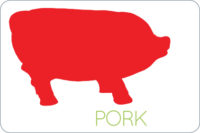There is a saying on that gridiron that for some teams to be successful, “The best offense is a good defense.” While this may be true on the football field, for too long in the meat industry, we’ve relied on playing good defense to be successful in getting our messages out to consumers. Now don’t get me wrong — we’ve still got a solid defense — but it is past time that we started playing a little offense, too.
That’s because negative news coverage and the popularity of books such as The Omnivore’s Dilemma, films such as “Food, Inc.” and activist movements such as “Meatless Mondays” are giving profile to myths about food production that are based neither on facts nor science.
Americans’ lack of connection to food production has made many people susceptible to these myths — myths about the safety of the meat and poultry supply, our products’ nutritional value, animal welfare, livestock production methods and environmental impact, to name a few. This disconnect has left some people with an impression that U.S. food is produced by an uncaring machine, instead of by millions of people who feed their families the very the same food they sell to their customers.
Couple this disconnect with the advent of social media, and these myths can spread at lightning speed. As Winston Churchill said, “A lie can make it half way around the world before the truth has time to put its pants on.”
The fact of the matter is, people eat every day, and they want to trust those who provide them food. There are also a growing number of people who believe food is right up there with religion and politics on the “passion” scale. So the food industry and the meat industry, in particular, have the opportunity to deliver multiple, positive experiences. The emergence of so many channels of information presents a constant challenge for the industry in maintaining the trust that repeated safe and enjoyable eating experiences should deliver.
It also presents an opportunity. An opportunity to play offense. Not to “educate” consumers, but to empower them so that they can formulate their own decisions and opinions based on science and facts, and not movies and books.
Edelman Public Affairs monitors trust annually through its Annual Trust Barometer. In 2010, trust across the board — in NGOs, government, business, industry and media — tumbled.
Is trust lost forever? Not according to Edelman. In fact, trust in academic experts increased markedly — by eight points — to 70 percent, nudged forward as skepticism about government, media and corporations grew.
When it comes to food and agriculture, answers to questions about food safety, nutrition, the environment or animal welfare, some of the “conventional wisdom” commonly found on the Internet and in popular media often isn’t the “accurate” wisdom.Given the high level of trust assigned to academic experts, the meat science and academic communities have the credibility to provide information in a believable and trustworthy way.
That is why AMI teamed with the American Meat Science Association (AMSA) to launch our “Meat MythCrushers” campaign in an effort to reconnect Americans to modern food production and to “crush” some of the more popular myths associated today with meat and poultry. AMSA, academic experts, and animal and meat science departments at universities are extremely useful resources when information seems confusing or unclear.
Our campaign is centered on a Web site, www.meatmythcrushers.com, which features science-based information and resources in response to some of the most popular meat and poultry myths held by consumers, as identified by an AMI consumer poll conducted by Harris Interactive.
The site features dozens of videos with AMSA academic experts debunking the myths for consumers in a clear and comprehensible manner. A companion brochure, including detailed references to support statements, is also available on the site.
But these communications must be sustained and delivered through multiple channels including traditional and social media.
Also part of the campaign is a Facebook page, http://on.fb.me/eTuuAG, which serves as a forum to encourage dialogue about these meat and poultry myths. AMI has been utilizing Twitter to supplement the campaign and connect consumers to the Web site. And because video is one of the most compelling tools in social media today, we’ve posted on YouTube (the No. 2 search engine in the world, behind only Google) dozens of the videos featuring academic experts.
The Meat MythCrushers campaign should not be limited to the Internet, however, and it is not designed to be. It must be supplemented with direct communications through speeches to community groups, schools and even in personal conversations where information can be dispensed in a credible and personal way.
We know from experience that trust will not be granted easily. It must be earned over time through positive experiences and communications with consumers.
Consumers have so many choices in today’s meat case that they can select based upon their taste, budget, values and nutrition needs. We want them to have accurate information so that they can make informed choices and make the best choices for themselves and their families — that is the goal of the Meat MythCrushers campaign.
We have a long way to go, but we’re only in the first quarter. So I urge everyone in the industry to get off the sidelines and join the offense. Join the Facebook page, share the Web site, talk to consumers, talk to kids.
The state of the industry, and the ultimate final score, depend on it.





Report Abusive Comment